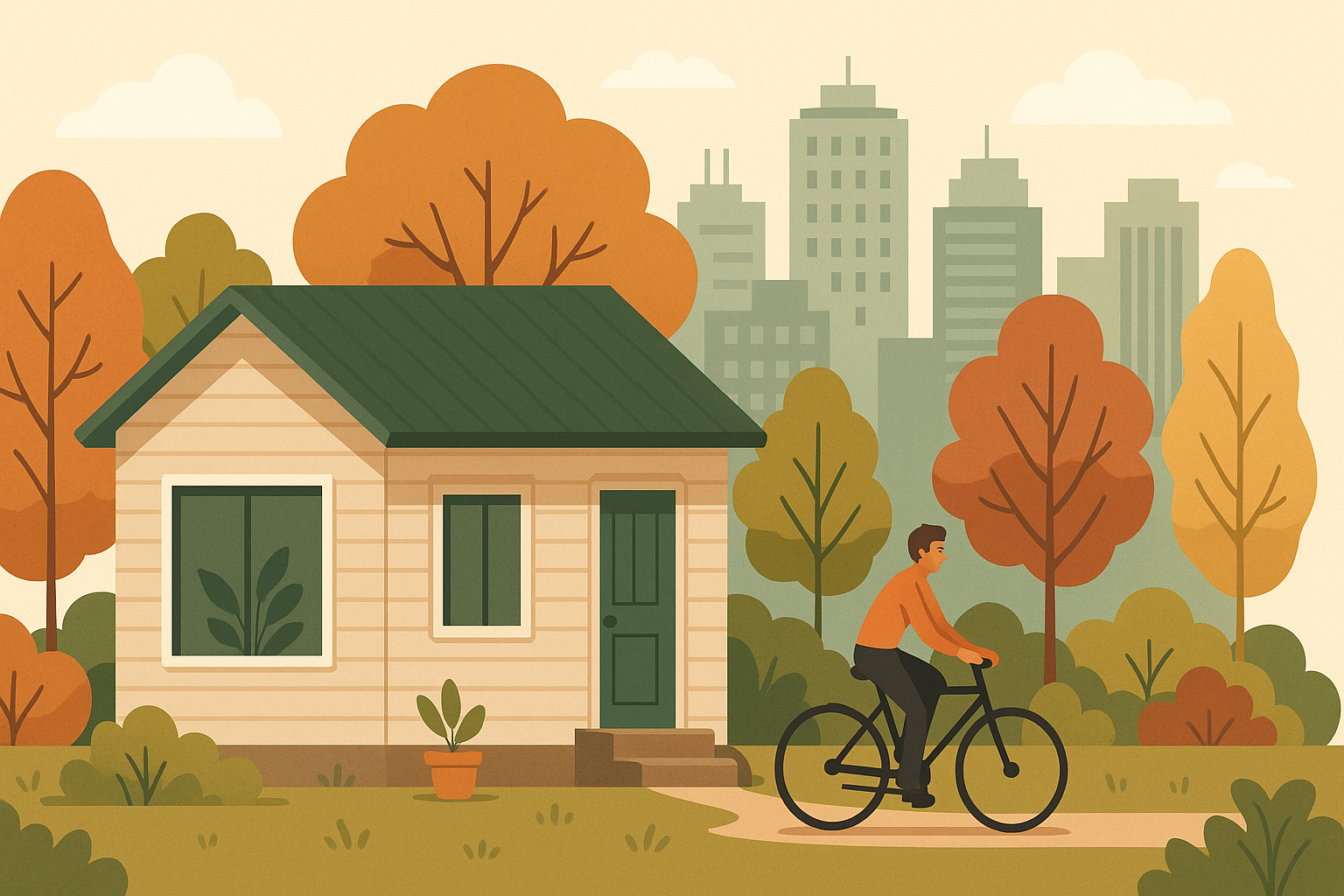
Car-Free ADU: The Future of Sustainable Urban Living in Canada
Estimated reading time: 7 minutes
Key Takeaways
- Car-free ADUs reduce dependency on private cars while promoting sustainable urban living.
- Sustainable mobility: Walkable neighbourhoods and transit-oriented development play a key role in building cleaner, healthier communities.
- Economic and environmental benefits are significant through cost savings and a decrease in urban emissions.
- Urban planning in Canada is evolving to support inclusive, accessible housing that enhances community bonds.
Table of contents
Introduction: Embracing Car-Free ADU and Car-Free Living
Car-free ADUs are changing how Canadians think about city life. A car-free ADU is an accessory dwelling unit — like a laneway house, garden suite, or basement apartment — designed or located to minimize the need for owning a private car. With car-free living on the rise in Canadian cities, many are searching for ways to simplify life, reduce costs, and protect our environment.
Today, more Canadians aim to live independently of vehicles. Dense cities and walkable neighbourhoods offer easy access to shops, schools, and parks. Choosing the right spot for an ADU — especially in a transit-rich area — makes car independence attainable. This decision not only cuts personal expenses but also supports a greener future by reducing emissions and parking needs. For more on these benefits, visit this source.
Social benefits are equally important. Living in a car-free ADU inspires more walking and biking, fostering stronger community bonds and vibrant street life. As one urban planner noted, “Designing cities for people, not cars, creates a canvas for community and creativity.”
Understanding Car-Free ADUs: Urban Planning Canada
What Is a Car-Free ADU?
A car-free ADU is an accessory dwelling unit structured to reduce or eliminate car reliance. They come in different forms:
- Laneway houses: Small homes built in backyards facing alleys or laneways.
- Garden suites: Detached structures set within a backyard.
- Basement apartments: Lower-level rental units in existing homes.
Car-free ADUs are integrated within the urban fabric, often excluding parking spaces and instead encouraging:
- Short walks to bus or subway stops
- Easy proximity to cycle routes and shared mobility services
- Convenient access to essentials like food, schools, and parks
This method focuses on designing housing around active transportation, not cars. It reflects best practices in urban planning in Canada, as detailed in this guide. For an in-depth look, explore this comprehensive guide.
Core Benefits of Car-Free ADUs
- Cost Savings:
- No need for expensive parking spaces
- Elimination of costs tied to car ownership like fueling and insurance
- Generally lower prices for rent or ownership in car-free units
(source)
- Reduced Environmental Impact:
- Fewer cars lead to less greenhouse gas emissions
- Minimized urban land use for parking
- Supports city climate goals and cleaner air
(source)
- Stronger Community Bonds:
- Increased walking and biking foster chance encounters
- Quieter, safer streets encourage public interaction
- Enhanced sense of belonging in vibrant public spaces
(source)
The Importance of Walkable Neighbourhoods: Walkable Neighbourhood
What Is a Walkable Neighbourhood?
Walkable neighbourhoods are urban areas where daily essentials are within walking or cycling distance. These communities boast:
- Interconnected street networks: Short blocks and direct walking paths
- Mixed-use developments: A blend of homes, shops, offices, and parks
- Safe pedestrian infrastructure: Wide sidewalks, crosswalks, and low-stress intersections
- Local amenities: Schools, recreation centres, and parks reachable in a 10–15 minute walk
How Walkability Supports Car-Free ADUs
Car-free ADUs thrive best in walkable neighbourhoods because:
- Proximity to essentials: Errands, cafes, and schools are just a short walk away.
- Active and healthy lifestyle: Regular walking and cycling improve overall well-being.
- Enhanced community spaces: Streets designed for pedestrians foster conversation and connection.
- Cost-effective living: Reduced need for transit fares and car expenses eases financial burdens.
For more insights on walkable design and its benefits, see this resource. Canadian cities like Montreal and Vancouver are already transforming their urban spaces to prioritize people over cars.
Additional perspectives are available from this source.
Transit-Oriented ADU Development: Transit-Oriented ADU
Understanding Transit-Oriented Development (TOD)
Transit-oriented development, or TOD, is a planning strategy that locates homes, shops, and jobs within easy reach of train stations, bus stops, and rapid transit. The aim is to make public transit the preferred choice for daily travel.
Within a TOD context, residents enjoy:
- Frequent, reliable transit: Regular bus, subway, or light rail services cover broad areas.
- Dense, mixed-use environments: Homes, stores, and services clustered together.
- Pedestrian-friendly streets: Well-lit, safe, and inviting for walking with appropriate signage and public art.
Why Place ADUs in TOD Areas?
Transit-oriented ADUs maximize access to public transit and active transport networks, offering benefits such as:
- High accessibility: Easy reach to jobs, schools, and recreation without a car.
- Reduced urban sprawl: Concentrated development near transit prevents the endless spread of cities.
- Cleaner air: Less reliance on cars means reduced transportation emissions.
- Lower traffic congestion: Fewer cars contribute to smoother urban mobility.
Municipal studies confirm that integrating car-free ADUs in TOD areas strengthens communities and supports responsible growth. Explore further details in this report or check out strategies for urban infill at this link.
Urban Planning in Canada: Urban Planning Canada
How Urban Planning Supports Car-Free ADUs
Urban planning in Canada is evolving to address the growing demands for affordable, sustainable, and inclusive communities.
- Zoning reforms: New bylaws now permit ADU construction in varied forms such as laneway homes and secondary suites.
- Investment in active transportation: Expanded bike lanes, improved sidewalks, and safer crossings are becoming the norm.
- Transit upgrades: Enhanced public transit services with frequent schedules, accessible stations, and integrated payment systems.
Cities such as Vancouver, Calgary, Edmonton, and areas in Ontario are leading the charge with these innovations. For more details, visit this comprehensive guide.
Policy Examples and Current Initiatives
Municipalities are now supporting ADU growth by:
- Allowing ADUs in neighbourhoods previously reserved for single-family homes.
- Encouraging mixed-use zoning for easy access to amenities.
- Funding infrastructure improvements to better link residences with transit and business hubs.
Despite significant progress, challenges such as restrictive planning rules and infrastructure upgrades remain. However, through continuous policy improvements and community engagement, Canadian cities can pave the way for a future where car-free ADU living is the norm.
For further reading, refer to this document.
Lifestyle Adjustments for Car-Free Living: Car-Free Living
Adapting Habits in ADU Communities
Transitioning to car-free living involves practical lifestyle adjustments. Here are some actionable tips:
- Prioritize walking and cycling:
- Utilize available sidewalks, bike lanes, and trails for daily errands.
- Invest in quality rain gear or winter tires for year-round mobility.
- Embrace public transit:
- Rely on high-frequency routes offered in dense urban areas.
- Leverage transit apps to monitor schedules and minimize wait times.
- Explore shared mobility services:
- Use car-share programs for occasional trips such as bulk shopping or travel outside the city.
- Opt for bikeshare schemes when you need a vehicle temporarily.
- Engage with your local community:
- Discover local cafes, libraries, and activity centres in your neighbourhood.
- Participate in block parties, farmers’ markets, or local arts events to meet neighbours.
Common concerns such as accessibility and safety can be addressed by supporting community initiatives that enhance pedestrian infrastructure and advocate for better street lighting and traffic calming measures. As highlighted by this source and that article, these changes bring us closer to a fully car-free lifestyle. For more lifestyle tips, visit this guide.
Conclusion: The Benefits of Car-Free ADU Living and Sustainable Mobility
Car-free ADUs present a viable solution for Canadians aiming to live greener, healthier, and more socially connected lives. By placing accessory dwelling units in walkable neighbourhoods and transit-rich areas, car-free living is not only possible but can be deeply rewarding.
Remember:
- Cost savings: Eliminate expenses related to car ownership and parking fees.
- Sustainable mobility: Embrace walking, cycling, and public transit to keep cities cleaner.
- Community strength: Enjoy vibrant, inclusive public spaces that foster social connections.
Ready to explore car-free options? Dive into ADUs, urban planning resources, and sustainable mobility programs to join thousands of Canadians framing a resilient and inspiring urban future.
Frequently Asked Questions
Q1: What exactly is a car-free ADU?
A car-free ADU is an accessory dwelling unit designed or located to reduce the need for private car ownership by emphasizing walkability and access to public transit.
Q2: How does living in a car-free ADU benefit the environment?
By reducing reliance on cars, car-free ADUs help lower greenhouse gas emissions and minimize urban space used for parking, thereby contributing to a cleaner, greener environment.
Q3: Are car-free ADUs suitable for families?
Yes, many car-free ADUs are located in vibrant, walkable neighbourhoods with easy access to schools, parks, and community services, making them ideal for families.
Q4: What should I consider before moving to a car-free ADU?
Consider the proximity to public transit, local amenities, and the overall walkability of the area. Visiting the neighbourhood and speaking with residents can also help in making an informed decision.

Leave a Reply